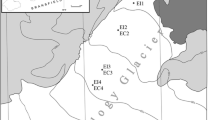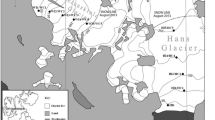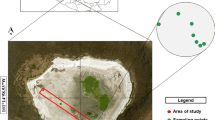Abstract
Microbial communities occurring in three types of supraglacial habitats—cryoconite holes, medial moraines, and supraglacial kames—at several glaciers in the Arctic archipelago of Svalbard were investigated. Abundance, biovolume, and community structure were evaluated by using epifluorescence microscopy and culturing methods. Particular emphasis was laid on distinctions in the chemical and physical properties of the supraglacial habitats and their relation to the microbial communities, and quantitative multivariate analyses were used to assess potential relationships. Varying pH (4.8 in cryoconite; 8.5 in a moraine) and texture (the proportion of coarse fraction 2% of dry weight in cryoconite; 99% dw in a kame) were found, and rather low concentrations of organic matter (0.3% of dry weight in a kame; 22% dw in cryoconite) and nutrients (nitrogen up to 0.4% dw, phosphorus up to 0.8% dw) were determined in the samples. In cryoconite sediment, the highest numbers of bacteria, cyanobacteria, and algae were found, whereas relatively low microbial abundances were recorded in moraines and kames. Cyanobacterial cells were significantly more abundant than microalgal ones in cryoconite and supraglacial kames. Different species of the cyanobacterial genus Leptolyngbya were by far the most represented in all samples, and cyanobacteria of the genera Phormidium and Nostoc prevailed in cultures isolated from cryoconite samples. These species are considered opportunistic organisms with wide ecological valency and strong colonizing potential rather than glacial specialists. Statistical analyses suggest that fine sediment with higher water content is the most suitable condition for bacteria, cyanobacteria, and algae. Also, a positive impact of lower pH on microbial growth was found. The fate of a microbial cell deposited on the glacier surface seems therefore predetermined by the physical and chemical factors such as texture of sediment and water content rather than spatial factors or the origin of sediment.





Similar content being viewed by others
References
Battin, TJ, Wille, A, Sattler, B, Psenner, R (2001) Phylogenetic and functional heterogeneity of sediment biofilms along environmental gradients in a glacial stream. Appl Environ Microbiol 67: 799–807
Benn, DI, Evans, DJA (1998) Glaciers and Glaciation. Arnold, London, p 734
Bloem, J, Deruiter, PC, Koopman, GJ, Lebbink, G, Brussaard, L (1992) Microbial numbers and activity in dried and rewetted arable soil under integrated and conventional management. Soil Biol Biochem 24: 655–665
Burns, BP, Goh, F, Allen, M, Neilan, BA (2004) Microbial diversity of extant stromatolites in the hypersaline marine environment of Shark Bay, Australia. Environ Microbiol 6: 1096–1101
Certini, G, Campbell, CD, Edwards, AC (2004) Rock fragments in soil support a different microbial community from the fine earth. Soil Biol Biochem 36: 1119–1128
Christner, BC, Kvitko, BH II, Reeve, JN (2003) Molecular identification of Bacteria and Eukarya inhabiting an Antarctic cryoconite hole. Extremophiles 7: 177–183
Elster, J, Lukešová, A, Svoboda, J, Kopecký, J, Kanda, H (1999) Diversity and abundance of soil algae in the polar desert, Sverdrup Pass, central Ellesmere Island. Polar Rec 35: 231–254
Elster, J, Svoboda, J, Komárek, J, Marvan, P (1997) Algal and cyanoprocaryote communities in a glacial stream, Sverdrup Pass, 79°N, Central Ellesmere Island, Canada. Arch Hydrobiol Suppl bd Algol Stud 85: 57–93
Evans, DJA (1990) The effect of glacier morphology on surficial geology and glacial stratigraphy in a high Arctic mountainous terrain. Z Geomorphol 34: 481–503
Flechtner, VR, Johansen, JR, Clark, WH (1998) Algal composition of microbiotic crusts from the central desert of Baja California, Mexico. Great Basin Nat 58: 295–311
Foght, J, Aislabie, J, Turner, S, Brown, CE, Ryburn, J, Saul, DJ, Lawson, W (2004) Culturable bacteria in subglacial sediments and ice from two southern hemisphere glaciers. Microb Ecol 47: 329–340
Fountain, AG, Tranter, M, Nylen, TH, Lewis, KJ, Mueller, DR (2004) Evolution of cryoconite holes and their contribution to meltwater runoff from glaciers in the McMurdo Dry Valleys, Antarctica. J Glaciol 50: 35–45
Gordon, DA, Priscu, JC, Giovannoni, S (2000) Origin and phylogeny of microbes living in permanent Antarctic lake ice. Microb Ecol 39: 197–202
Hagen, JO, Liestøl, O, Roland, E, Jørgensen, T (1993) Glacier Atlas of Svalbard and Jan Mayen. Meddelelser 129, Norsk Polarinstitutt, Oslo, p 141
Hillebrand, H, Dürselen, C-D, Kirschtel, D, Pollingher, U, Zohary, T (1999) Biovolume calculation for pelagic and benthic microalgae. J Phycol 35: 403–424
Johansen, JR, Britton, C, Rosati, TC, Li, X, St. Clair, LL, Webb BL, Kennedy AJ, Yanko KS (2001) Microbiotic crusts of the Mojave Desert: factors influencing distribution and abundance. Nova Hedwigia 123: 339–369
Kaštovská, K, Elster, J, Stibal, M, Šantrůčková, H (2005) Microbial assemblages in soil microbial succession after glacial retreat in Svalbard (High Arctic). Microb Ecol 50: 396–407
Kaštovská, K, Stibal, M, Šabacká, M, Černá, B, Šantrůčková, H, Elster, J (in press) Microbial community structure and ecology of subglacial sediments in two polythermal Svalbard glaciers characterized by the epifluorescence microscopy and PLFA. Polar Biol
Kepner, RL, Pratt, JR (1994) Use of fluorochromes for direct enumeration of total bacteria in environmental samples—past and present. Microbiol Rev 58: 603–615
Komárek, O, Komárek, J (2001) Contribution to the taxonomy and ecology of green cryosestic algae in the summer season 1995–96 at King George Island, S. Shetland Islands. Nova Hedwigia 123: 121–140
Kopáček, J, Hejzlar, J (1995) Semi-micro determination of total phosphorus in soils, sediments, and organic materials—a simplified perchloric-acid digestion procedure. Commun Soil Sci Plant Anal 26: 1935–1946
Lukešová, A (1993) Soil algae in four secondary successional stages on abandoned fields. Arch Hydrobiol Suppl Bd Algol Stud 71: 81–102
Lukešová, A, Hoffmann, L (1996) Soil algae from acid rain impacted forest areas of the Krušné hory Mts., 1. Algal communities. Vegetatio 125: 123–136
Lyons, WB, Welch, KA, Fountain, AG, Dana, GL, Vaughn, BH, McKnight, DM (2003) Surface glaciochemistry of Taylor Valley, southern Victoria Land, Antarctica and its relationship to stream chemistry. Hydrol Process 17: 115–130
Marshall, WA, Chalmers, MO (1997) Airborne dispersal of Antarctic algae and cyanobacteria. Ecography 20: 585–594
McIntyre, NF (1984) Cryoconite hole thermodynamics. Can J Earth Sci 21: 152–156
Mueller, DR, Pollard, WH (2004) Gradient analysis of cryoconite ecosystems from two polar glaciers. Polar Biol 27: 66–74
Mueller, DR, Vincent, WF, Pollard, WH, Fritsen, CH (2001) Glacial cryoconite ecosystems: a bipolar comparison of algal communities and habitats. Nova Hedwigia 123: 173–197
Paerl, HW, Priscu, JC (1998) Microbial phototrophic, heterotrophic, and diazotrophic activities associated with aggregates in the permanent ice cover of Lake Bonney, Antarctica. Microb Ecol 36: 221–230
Porazinska, DL, Fountain, AG, Nylen, TH, Tranter, M, Virginia, RA, Wall, DH (2004) The biodiversity and biogeochemistry of cryoconite holes from McMurdo Dry Valley glaciers, Antarctica. Arct Antarct Alp Res 36: 84–91
Price, PB (2000) A habitat for psychrophiles in deep Antarctic ice. Proc Natl Acad Sci USA 97: 1247–1251
Řehák, J, Ouhrabka, V, Braun, M (1990) New information about the interior drainage of a subpolar glacier and the structures of medial moraines of the Southwest Spitsbergen. Stud Carsol 1: 15–56
Řehák, J, Řehák, J Jr, Řehák, S (2004) Penetration of subglacial channel systems of Torell and Werenskiold glaciers. Proceedings of XIV Seminar on Polar Meteorology and Climatology, Marine Academy, Gdynia, Poland
Säwström, C, Mumford, P, Marshall, W, Hodson, A, Laybourn-Parry, J (2002) The microbial communities and primary productivity of cryoconite holes in Arctic glacier (Svalbard 79°N). Polar Biol 25: 591–596
Sharp, M, Parkes, J, Cragg, B, Fairchild, IJ, Lamb, H, Tranter, M (1999) Widespread bacterial populations at glacier beds and their relationship to rock weathering and carbon cycling. Geology 27: 107–110
Sigler, WV, Bachofen, R, Zeyer, J (2003) Molecular characterization of endolithic cyanobacteria inhabiting exposed dolomite in central Switzerland. Environ Microbiol 5: 618–627
Skidmore, ML, Foght, JM, Sharp, MJ (2000) Microbial life beneath a high Arctic glacier. Appl Environ Microbiol 66: 3214–3220
Stibal, M, Elster, J (2005) Growth and morphology variation as a response to changing environmental factors in two Arctic species of Raphidonema (Trebouxiophyceae) from snow and soil. Polar Biol 28: 558–567
Takeuchi, N (2002) Optical characteristics of cryoconite (surface dust) on glaciers: the relationship between light absorbency and the property of organic matter contained in the cryoconite. Ann Glaciol 34: 409–414
Takeuchi, N, Kohshima, S (2004) A snow algal community on Tyndall Glacier in the Southerm Patagonian icefield, Chile. Arct Antarct Alp Res 36: 92–99
Takeuchi, N, Kohshima, S, Seko, K (2001) Structure, formation, and darkening process of albedo-reducing material (cryoconite) on a Himalayan glacier: a granular algal mat growing on the glacier. Arct Antarct Alp Res 33: 115–122
ter Braak, CJF, Šmilauer, P (2002) CANOCO Reference Manual and CanoDraw for Windows User's Guide: Software for Canonical Community Ordination (version 4.5). Microcomputer Power, Ithaca, p 550
Tranter, M, Fountain, AG, Fritsen, CH, Lyons, WB, Priscu, JC, Statham, PJ, Welch, KA (2004) Extreme hydrochemical conditions in natural microcosms entombed within Antarctic ice. Hydrol Process 18: 379–387
Wadham, JL, Bottrell, S, Tranter, M, Raiswell, R (2004) Stable isotope evidence for microbial sulphate reduction at the bed of a polythermal high Arctic glacier. Earth Planet Sci Lett 219: 341–355
Wharton, RA Jr, McKay, CP, Simmons, GM Jr, Parker, BC (1985) Cryoconite holes on glaciers. BioScience 35: 499–503
Wharton, RA Jr, Vinyard, WC, Parker, BC, Simmons, GM Jr, Seaburg, KG (1981) Algae in cryoconite holes on Canada Glacier in Southern Victoria land, Antarctica. Phycologia 20: 208–211
Yoshimura, Y, Kohshima, S, Ohtani, S (1997) A community of snow algae on a Himalayan glacier: change of algal biomass and community structure with altitude. Arct Alp Res 29: 126–137
Acknowledgments
This work was supported by the grants GA ASCR B6005409 and AVOZ 60050516. Delegation Fund of the Faculty of Biological Sciences provided financial support for M.S. and M.Š. Barbora Černá performed the bacterial counts. Josef Řehák and Stanislav Řehák are thanked for their help in the field and for valuable comments on glacier hydrology. University of Wrocław kindly enabled us to stay at the Baranowski station. Three anonymous reviewers are thanked for their valuable comments on the manuscript.
Author information
Authors and Affiliations
Corresponding author
Rights and permissions
About this article
Cite this article
Stibal, M., Šabacká, M. & Kaštovská, K. Microbial Communities on Glacier Surfaces in Svalbard: Impact of Physical and Chemical Properties on Abundance and Structure of Cyanobacteria and Algae. Microb Ecol 52, 644–654 (2006). https://doi.org/10.1007/s00248-006-9083-3
Received:
Accepted:
Published:
Issue Date:
DOI: https://doi.org/10.1007/s00248-006-9083-3




